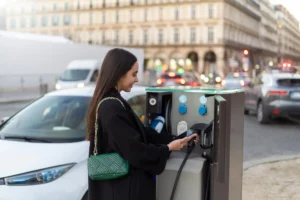
Home / EV Charging News / Electric Cars and Sustainable Tourism in Historic Cities
In the intricate tapestry of historic cities, where time-honored architecture and cultural richness coexist, the promotion of sustainable tourism is both a necessity and a delicate dance. This exploration delves into the promise and hurdles of introducing electric cars to the tourism narrative of these cities. By dissecting challenges and proposing solutions, we aim to uncover how electric vehicles can seamlessly integrate into the exploration of historically significant urban areas, offering a cleaner, more eco-friendly alternative.
The allure of historic cities lies in their ability to transport visitors to bygone eras, but the surge in tourism often jeopardizes their delicate balance. Conventional transportation methods contribute to pollution and congestion, prompting the search for alternatives. Electric cars emerge as a beacon of hope, promising a sustainable solution without compromising the intrinsic charm of historical sites.
Yet, challenges abound in the marriage of electric vehicles with historical settings. The practicality of installing charging stations encounters hurdles posed by limited space and strict regulations. Moreover, the seamless integration of electric cars into the visual narrative of historic cities becomes an artful challenge, demanding innovative design thinking.
Addressing these challenges requires a thoughtful approach. Concealed charging stations and underground infrastructure present a discreet solution to the space limitations in historic areas. Collaborations between automotive designers and heritage preservationists can birth electric vehicles designed not as intruders but as respectful companions to historical aesthetics.
Embracing electric cars extends beyond preservation; it’s a commitment to a sustainable future. By significantly reducing emissions and noise pollution, electric vehicles become silent custodians of air quality in historic cities. Tourists, in turn, benefit from a more serene and immersive experience, allowing them to absorb the historical ambiance without the intrusive hum of traditional engines.
Central to the success of electric vehicle integration is community involvement. Educational initiatives, public forums, and engagement campaigns become vital tools in fostering understanding and gaining support for sustainable tourism initiatives. By demystifying the benefits and dispelling concerns, a community can become the driving force behind positive change.
Transitioning historic cities into a sustainable future is an art. It requires a delicate balance between preserving the essence of the past and embracing the innovations of the present. Electric cars, with their silent efficiency and eco-friendly footprint, embody this balance. Their introduction represents not a departure from tradition, but a nuanced evolution towards a future where the stories of the past are told with a sustainable whisper.
Ensuring that electric cars seamlessly blend into the visual tapestry of historic cities is a task requiring a fusion of technology and artistic sensibility. Designers must navigate the intricate details of architectural styles, colors, and textures to create electric vehicles that are not only environmentally conscious but also aesthetically respectful. The result should be vehicles that enhance the urban landscape rather than disrupt it.
Installing charging stations in narrow cobblestone streets and centuries-old squares is no simple feat. However, the challenges of limited space can be transformed into opportunities for innovation. Concealed charging infrastructure, integrated into existing structures or hidden beneath historical surfaces, becomes a form of infrastructure in disguise, minimizing visual impact while providing the necessary support for electric vehicle adoption.
The benefits of electric cars in historic cities extend beyond their environmental contributions. Tourists, seeking an authentic experience, can immerse themselves in the rich history without the background hum of combustion engines. The electric vehicle becomes a silent guide, facilitating exploration without disrupting the serenity of historical sites, creating an experience that aligns with the ethos of preservation and respect.
For this vision of sustainable tourism to flourish, governmental support and policy advocacy are essential. Governments play a crucial role in incentivizing businesses to adopt eco-friendly practices, offering subsidies for electric vehicle infrastructure, and implementing policies that align with the goals of both sustainability and heritage preservation.
In conclusion, the integration of electric cars into the tapestry of historic cities is not merely a possibility; it is a call to action. It is a call to architects, urban planners, policymakers, and the community to come together in crafting a sustainable tomorrow. By navigating the challenges, embracing innovative solutions, and fostering a collective commitment to change, historic cities can become beacons of both cultural heritage and environmental stewardship. Through the seamless integration of electric vehicles, these cities can embark on a journey towards a future where tradition and innovation walk hand in hand, leaving a legacy of sustainable tourism for generations to come.
In the grand narrative of sustainable tourism in historic cities, electric cars emerge not as disruptors but as harmonious contributors. By addressing infrastructure challenges, embracing innovative design solutions, and fostering community support, these cities can usher in a greener, more sustainable tourism era. The charm of the past can coexist seamlessly with the technologies of the future, ensuring that each exploration is a step towards a tomorrow where history and sustainability walk hand in hand.
